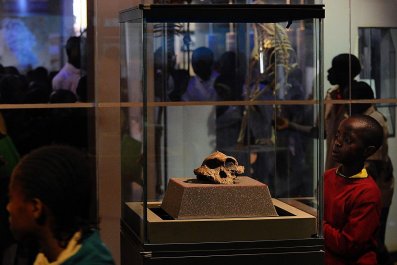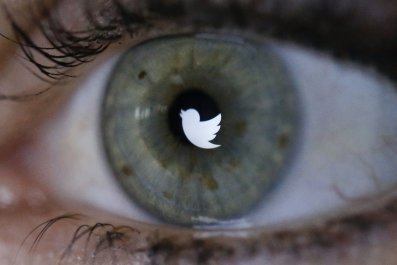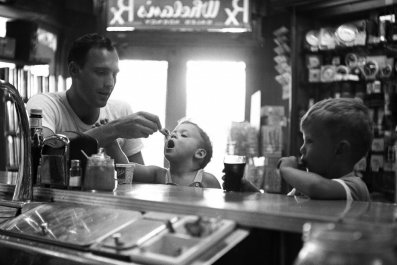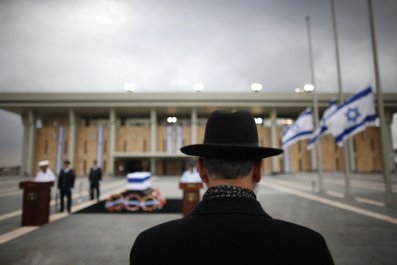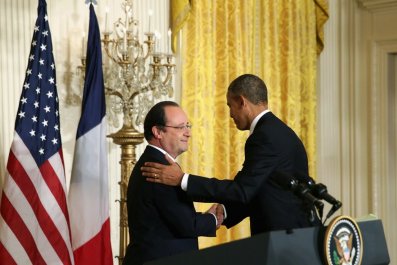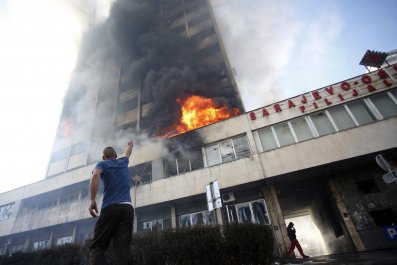What do you think of when you think of Tampa? Probably nothing. At worst, it's thought of as a town of strip clubs, shopping centers and suburban sprawl, as well as every stripe of sex scandal - from Debra Lafave, the high school teacher who seduced her student, to Jill Kelley, the socialite threatened by retired general David Petraeus's mistress. At best, it's thought of as a town that can handle big-ticket events like the 2012 Republican National Convention.
Even Girls creator Lena Dunham has weighed in on Tampa's alleged ignobility. At a campaign fund-raiser last summer, she decried the lack of affordable housing and income inequality in New York City as inhospitable to young creatives, saying it's driving them to "greener pastures, even Tampa."
"We can't have our generation's Patti Smith moving to Tampa," she warned.
Perhaps Tampa hasn't shed its seedier rep because it lacks an identity - ask any Tampa resident or native, including this writer, what it means to be from Tampa and they'll be hard pressed to answer. Such is the fate of many small and mid-sized cities without a cohesive geographic center, and is a common complaint among transplants from what they think are bigger, better places. To ask what it means to be from Phoenix or Boca Raton or, well, Tampa, is to question whether it means anything.
And so, every year, Tampa offers up an answer - Gasparilla.
The Ye Mystic Krewe of Gasparilla Invasion and Parade of Pirates, as it's formally known, is exactly what it sounds like: an annual parade with a pirate theme. Gasparilla, now in its 104th year, has grown to some 500,000 attendees, making it the third-largest parade in the U.S., generating some $22 million in hotel and restaurant receipts in the Tampa Bay area, according to organizers. Half of those parade-goers are from out of town.
Tampa's pirate legacy is thin compared to, say, Charleston, S.C., which was blockaded by Blackbeard. Gasparilla celebrates the probably fictional pirate Jose Gaspar, a nobleman from Seville, Spain, who took to piracy to avoid prison for kidnapping a young woman. He marauded the Southwest coast of Florida from the late 1700s to the early 1800s, and when cornered by the U.S. Navy he was said to have attached an anchor to his waist and jumped in the water, yelling, "Gasparilla dies from his own hand, not the enemy's!"
The day of the parade (always on a Saturday in late January or early February) is preceded by several highly choreographed, high-camp events. First, there's the ceremonial kidnapping of the mayor: some 30 men dressed as pirates confront the mayor in Tampa's center and demand the key to the city. Then they break for lunch at a social club located atop one of Tampa's skyscrapers. The mayor demurs; the pirates give him a few days to think it over. Then, on the following Saturday, the pirates sail on the "only full-sized pirate ship in the U.S.," along with 500 smaller boats, across Hillsborough Bay to the convention center. Again they demand the key to the city. The mayor finally relents, having work to do, and the pirates throw a party, a.k.a. Gasparilla.
There's also an alcohol-free children's parade and alcohol-soaked night parade on other dates, as well as other activities during the two weeks or so of Gasparilla season, but the main event is the Saturday shindig. "It puts Tampa on the map," said Don Barnes, one of six full-time staffers employed by the Krewe to organize Gasparilla and related events. "It highlights Tampa as a tourist destination."
Gasparilla the parade isn't that different from Mardi Gras - there are floats and beads and cleavage-baring women waving at floats to acquire said beads and drunk people, lots and lots of drunk people - except they're mostly dressed with a pirate motif. And Mardi Gras is traditionally followed by Lent, and penitence. In Tampa, not so much.
But it's a half-million people - encompassing all ages, races, genders, sexual orientations, socioeconomic backgrounds, political and religious affiliations, including a small, yet vocal, contingent of Jews for Jesus - coming together on Tampa's most exclusive stretch of real estate, a mansion-lined boulevard overlooking the water called Bayshore, to toast a fake pirate.
No wonder Tampa has an identity crisis.
Maybe a deeper cultural meaning of Gasparilla can be found in an official venue, like the Ye Mystic Krewe's pre-Gasparilla ball held the Thursday before the Parade. This Krewe is a civic organization composed of Tampa's Who's Who. They're the first Krewe and, for all effective purposes, the group that started Gasparilla - and as such get the privilege of playing Gaspar's pirates during the invasion.
For a long time, the Krewe's membership was all white and all male. In 1991, the city canceled Gasparilla when the Krewe refused to admit black members. They relented and the parade resumed the following year, and now there are more Krewes and Gasparilla as a whole is said to be more diverse.
The Mystic Krewe nevertheless maintains some elements of exclusivity. For example, the organization won't disclose its membership rolls or demographics - just that there are somewhere between 500 and 1,000 Krewe members. "It's a shipload," a Gasparilla spokesman explains.
The Krewe's representative maintains that "it's not a secret society," but rather "a private organization." They simply don't talk about the identity of their members. "That's why we dress like pirates. You wouldn't know it's your doctor or lawyer walking down the street" or even "one of the most prominent ob-gyns in Tampa."
The reason for anonymity at the ball is less clear. Krewe members, in expensive pirate attire - custom made leather boots and puffy shirts, à la Seinfeld - gyrate with their wives and girlfriends to a playlist that could have been blasted at any middle school dance. Though the ladies were not dressed as pirates - for them, it was more Herve Leger-style bandage dresses or glittery, bodiced gowns. Some seemed to welcome the gala as an excuse to wear fur in Florida.
Gasparilla's flack asked Newsweek to exit the ball around 10:45; after that people may have had a bit to drink, he explained.
A man who had been invited by a Krewe member to be a "guest pirate" preferred not to be identified for fear of social ramifications; he was amused by his surroundings but added: "There are a few of us Jews, but it's the epitome of establishment. Very WASP-y.
"There's s**ty food and nowhere to go to the bathroom. It's like, a bunch of dudes," he says, but, "You get to dress up as pirates!
"We all get really drunk," he adds. "This is the one weekend of the year when we can just have fun. It's like being back at the frat house. We're all little boys at heart."
Tiger Lee, proprietor of Pirate Fashions N Photos - "the world's largest pirate store," he claims - greets all customers with a command: "Ahoy, matey! You must ring me bell and ask permission to board." Customers are actually required to ring the bell and, if Lee consents, unhook a rope to access the some 4,000-square-foot showroom and workshop - which employs approximately eight craftspeople year round, including a journeyman gunsmith, who make all things pirate. (When customers disembark upon checkout, Lee either says "May your horizons be filled with treasures!" or "Shove off!" depending on their demeanor.)
In addition to this, Lee offers "black powder" classes, for those interested in safely shooting historic guns, and sword fighting tutorials. His products and services - and sartorial expertise - have been used not just in Tampa but in the entertainment industry worldwide, such as a recent Vice documentary on the golden age of pirates.
Lee admits that the festival doesn't hold the record for gathering the most pirates in one place, but chalks that up to logistics - you'd have to photograph and count them all at once, which is impossible with Gasparilla's scale, he says.
Lee used to have a store in St. Augustine; despite that city's greater historic relation to pirates and focus on authenticity and preservation, people weren't as into being pirates - which was bad for business.
In Tampa, he says, "they're more willing to spend money on handmade craftsmanship" despite an inherent lack of pirate culture. "Tampa isn't big on authenticity," he says.
***
A group of men in their 20s in an alley are sharing a Breathalyzer.
"I can't drive!" declares "Mel," who's wearing a cutoff Dale Earnhardt Jr. T-shirt, camo shorts, and crocs. He passes the device to "Billy," who, after putting it to his lips, boastfully smiles at the results. (Names initially in quotes are not the real names of the revelers, for reasons that should be obvious.)
"Billy can't drive!" Mel announces, honking an air horn.
"I'm going to be regretting this in an hour, when I'm passed out," Mel chuckles.
It's a little after 9 a.m. on Gasparilla.
The parade doesn't start until 2:30 p.m., but the many people who live near the parade route start early if not the night before, inviting as many guests as possible to park their cars and their nearly comatose bodies at their conveniently located abodes.
The too-drunk-to drive duo, along with 10 or so friends, took turns playing beer-pong as more and more guests, who all seemed to know someone who knew the person renting an apartment there, strayed into the yard.
A young man wearing a Camelback and carrying a plastic sword, wanders up to their game from the street. "Is there a Ron here that knows a Michael?" he asks.
"Elbow!" one of the pong players shouts, calling foul.
No, nobody knows a Ron, someone says, but stay and have a drink. The accidental guest thanks them but scurries back to the street.
A buxom brunette then walks up, also with a plastic sword. "Gasparilla!" she shouts, accentuating her cry with a "woo!" Mel calls back "Gasparilla!" also with a "woo!" blowing the air horn again.
"Porno' showin', up and down and up they go!" a rap song blares in the background as guests increasingly stray into the hostesses' kitchen, in search of beer.
This party supposedly has a Rednecks and Mexicans theme - some guests say they were told to dress as rednecks or Mexicans, but not redneck Mexicans.
A few attendees wear Free Tilly shirts, referring to the killer whale, muddying the party's alleged theme.
Someone has a Sharpie and the lithe blonde hostess starts tattooing guests with the permanent marker. Mel wants a Confederate flag on his bicep. "Stars and bars, baby!" Someone else wants barbed wire. Another wants a teardrop on his face, just like what some prison inmates have.
One young man, showing off iPhone photos of his exploits from the night before, laments: "So I posted this picture and like, 30 seconds later somebody commented '50 Shades of Gay.' "
"Rod" - one of several young men in a purple sombrero - looks on and smiles. Rod is an EMT living in Florida's panhandle and he has made an important declaration: It's not yet 10 a.m., and he can already tell that his first Gasparilla is the best bacchanal of his life. "It's like the Mardi Gras and spring break combined," he says. "It's better."
Why? He doesn't know. He's also not sure if he'll make the parade. The parade is kind of whatever, he explains.
"Fonzi," an accountant living in Orlando, drove about two hours to Tampa that day for his first Gasparilla. He isn't committing to the parade either.
"It's a parade," he says dismissively. "Plus, you can't take alcohol - you have to buy it from a vendor, which is "bulls*t."
And, he says, a block is kind of far to walk when you're that drunk.
Around 1:30 in the afternoon, "Eugene" and "Carol," a raven-headed girl he'd been seeing, wait at an apartment complex a mile from the parade route. As they poured drink after drink into red Solo cups, the host, an Army vet who went by "Ratchet Rodney," kept apologizing. His apartment smells, he knows, but he needs to clean his cat's litterbox.
"Come on, let's get drunk and get outta here or we're going to miss the parade," Eugene says, bored.
"I'm already a little drunk," Eugene's girl says. "But I want to get drunker. I need to get drunker. It's Gasparilla."
As they walk, Eugene jokingly complains of the seven-block hike to the parade route. "I've walked so much I'm not even drunk anymore!"
"Me neither," Carol sighs.
All is calm once the parade commences until the trickle of floats seems to slow and then stop, leaving hundreds of thousands of drunk, hungry-looking people milling about, looking for the next thing to do.
Someone announces they have to go to the bathroom but don't want to go outside or in a port-o-potty. Eugene, who has slipped away from the group, reappears from behind a convenience store. "I just pissed on a Hummer!" he announces, laughing.
The group decides to walk back to their cars, backtracking on the route of the parade.
A middle-age woman in a silk corset, holding a bottle of Fireball whiskey, poses for a photo with a police officer near a No Drinking Beyond This Point sign.
Rodney strolls off, hoping to snap some photos of a few women dressed as pirates. They give him the finger, and he skulks back.
Fonzi calls out from the distance. He's sitting on a wall with a sleepy-looking strawberry blonde who, extending a moist palm, introduces herself as Melanie. Fonzi has thought about it some more, he says, and now that he made it to the parade he thinks he now knows what Gasparilla is all about.
"I met a lot of really great people, like Melanie."
"It's what they wear that bothers me," a reanimated Melanie suddenly opines of the crowd. "It's not Halloween. They spend dollars, like, hundreds of them. You can tell."
"It's more of a history thing," Fonzi says.
"Gasparilla was a pirate that landed in Tampa," Melanie adds.
"No, Gasparilla was not a pirate."
Melanie turns more toward Fonzi and, studying his face, says: "I don't even know you're name."







